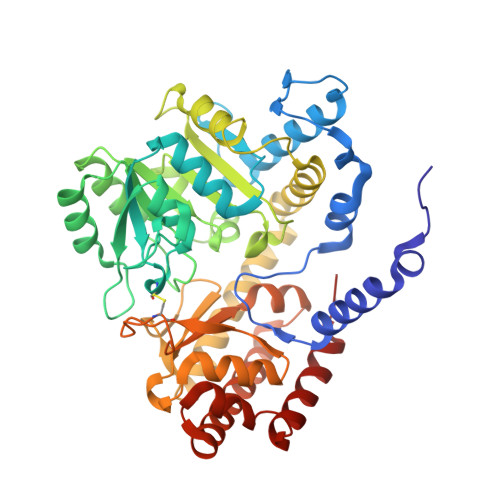Structures of Plasmodium vivax serine hydroxymethyltransferase: implications for ligand-binding specificity and functional control.
Chitnumsub, P., Jaruwat, A., Riangrungroj, P., Ittarat, W., Noytanom, K., Oonanant, W., Vanichthanankul, J., Chuankhayan, P., Maenpuen, S., Chen, C.J., Chaiyen, P., Yuthavong, Y., Leartsakulpanich, U.(2014) Acta Crystallogr D Biol Crystallogr 70: 3177-3186
- PubMed: 25478836
- DOI: https://doi.org/10.1107/S1399004714023128
- Primary Citation of Related Structures:
4OYT, 4PFF, 4PFN - PubMed Abstract:
Plasmodium parasites, the causative agent of malaria, rely heavily on de novo folate biosynthesis, and the enzymes in this pathway have therefore been explored extensively for antimalarial development. Serine hydroxymethyltransferase (SHMT) from Plasmodium spp., an enzyme involved in folate recycling and dTMP synthesis, has been shown to catalyze the conversion of L- and D-serine to glycine (Gly) in a THF-dependent reaction, the mechanism of which is not yet fully understood. Here, the crystal structures of P. vivax SHMT (PvSHMT) in a binary complex with L-serine and in a ternary complex with D-serine (D-Ser) and (6R)-5-formyltetrahydrofolate (5FTHF) provide clues to the mechanism underlying the control of enzyme activity. 5FTHF in the ternary-complex structure was found in the 6R form, thus differing from the previously reported structures of SHMT-Gly-(6S)-5FTHF from other organisms. This suggested that the presence of D-Ser in the active site can alter the folate-binding specificity. Investigation of binding in the presence of D-Ser and the (6R)- or (6S)-5FTHF enantiomers indicated that both forms of 5FTHF can bind to the enzyme but that only (6S)-5FTHF gives rise to a quinonoid intermediate. Likewise, a large surface area with a highly positively charged electrostatic potential surrounding the PvSHMT folate pocket suggested a preference for a polyglutamated folate substrate similar to the mammalian SHMTs. Furthermore, as in P. falciparum SHMT, a redox switch created from a cysteine pair (Cys125-Cys364) was observed. Overall, these results assert the importance of features such as stereoselectivity and redox status for control of the activity and specificity of PvSHMT.
Organizational Affiliation:
National Center for Genetic Engineering and Biotechnology (BIOTEC), National Science and Technology Development Agency (NSTDA), 113 Thailand Science Park, Phahonyothin Road, Klong Nueng, Klong Luang, Pathum Thani 12120, Thailand.















